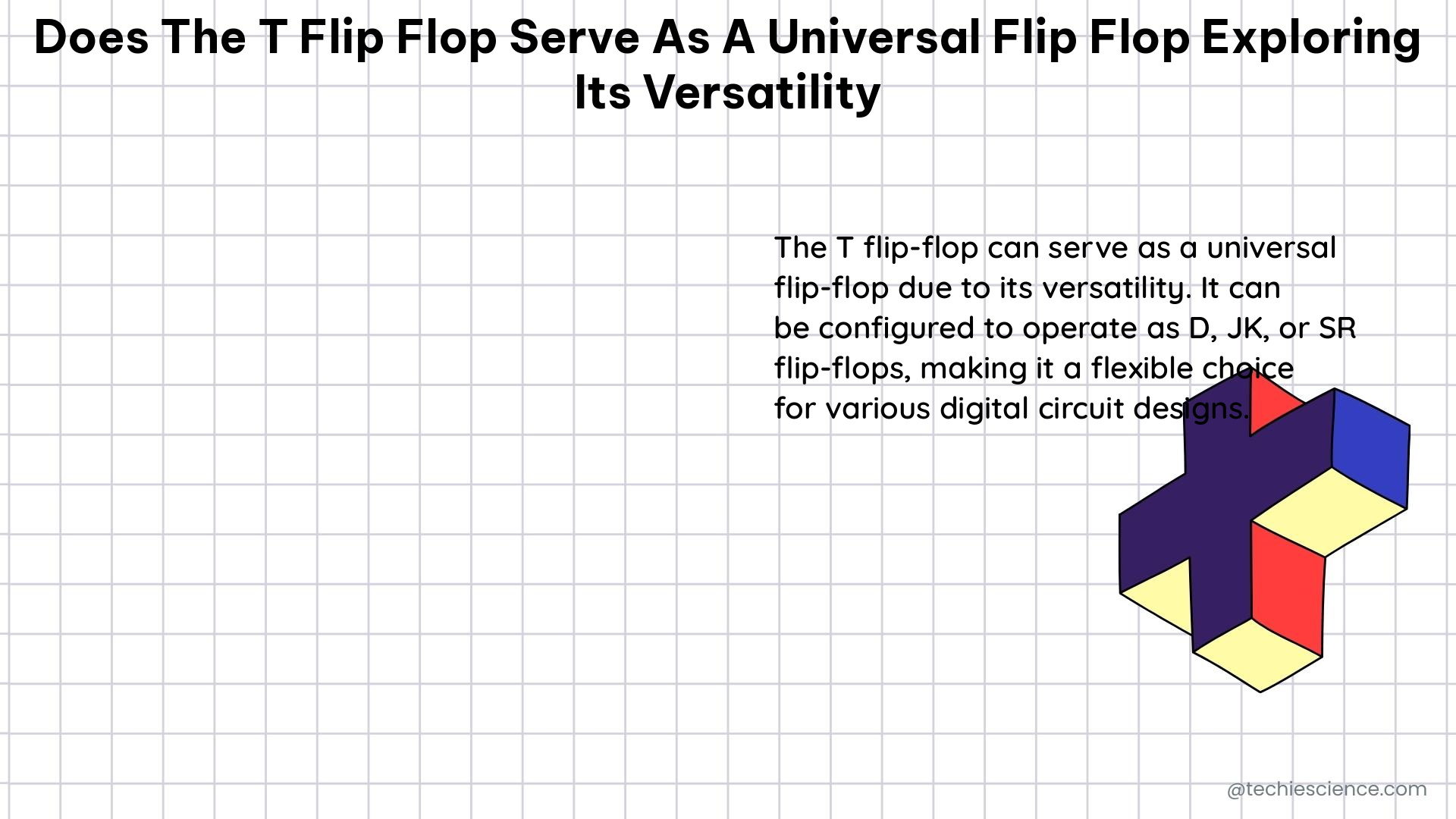The T flip-flop, also known as the Toggle flip-flop, is a versatile digital electronic component used for storing one bit of information. It can toggle its output depending on the input, making it a valuable tool in various applications such as data storage, signal processing, and control.
Understanding the T Flip-Flop
The T flip-flop can be constructed in three ways: using SR flip-flops, D flip-flops, or JK flip-flops. It has a basic block diagram containing Toggle and clock inputs, as well as Q and Q’ complemented inputs. The T flip-flop operates based on two cases:
- When T = 0 and the clock pulse is high (1), the output remains the same as the previous value, known as the Hold state.
- When T = 1, the output toggles, meaning the bit is flipped from 1 to 0 or from 0 to 1.
Truth Table and Characteristic Equation
The Truth table of a T flip-flop is as follows:
| T | Q(t) | Q(t+1) |
|---|---|---|
| 0 | 0 | 0 |
| 0 | 1 | 1 |
| 1 | 0 | 1 |
| 1 | 1 | 0 |
The Characteristic equation of a T flip-flop is:
Q(t+1) = T’Q(t) + TQ'(t)
This equation describes the relationship between the current state (Q(t)) and the next state (Q(t+1)) based on the Toggle input (T).
Excitation Table
The Excitation table of a T flip-flop is as follows:
| T | Q(t) | Q(t+1) |
|---|---|---|
| X | 0 | 0 |
| 1 | 0 | 1 |
| X | 1 | 1 |
| 0 | 1 | 0 |
The Excitation table provides a clear understanding of the input conditions required to achieve the desired output state.
Versatility of the T Flip-Flop

The T flip-flop is widely used in various applications due to its versatility:
- Data Storage: T flip-flops can be used to store one bit of information, making them useful in digital memory and storage devices.
- Signal Processing: T flip-flops can be used in shift registers, which are essential components in signal processing applications such as digital filters, digital signal generators, and digital communication systems.
- Control Applications: T flip-flops can be used in control systems, where they are employed to toggle the state of a system based on input signals.
- Frequency Division: T flip-flops can be used to divide the frequency of a clock signal, making them useful in digital clock circuits and frequency synthesizers.
- Counting and Timing: T flip-flops can be used to build binary counters, which are essential in digital timing and counting applications.
- Ripple Counters: T flip-flops can be cascaded to form ripple counters, which are widely used in digital circuits for counting and timing purposes.
- Synchronization: T flip-flops can be used to synchronize digital signals, ensuring that data is transferred correctly between different parts of a digital system.
Advantages of the T Flip-Flop
The T flip-flop offers several advantages that make it a versatile and valuable component in digital electronics:
- Simplicity: The T flip-flop has a simple structure and operation, making it easy to understand and implement in digital circuits.
- Flexibility: The T flip-flop can be constructed using various types of flip-flops, such as SR, D, or JK, providing flexibility in circuit design.
- Reliability: T flip-flops are known for their reliability and stability, making them suitable for use in mission-critical applications.
- Power Efficiency: T flip-flops can be designed to be power-efficient, making them suitable for use in low-power digital systems.
- High-Speed Operation: T flip-flops can operate at high speeds, making them suitable for use in high-frequency digital circuits.
- Scalability: T flip-flops can be easily scaled up or down to meet the requirements of different digital systems, making them versatile and adaptable.
Limitations and Considerations
While the T flip-flop is a versatile component, it also has some limitations and considerations:
- Timing Constraints: T flip-flops, like other flip-flops, have specific timing constraints, such as setup and hold times, that must be met to ensure proper operation.
- Metastability: T flip-flops, like other flip-flops, can experience metastability, which can lead to unpredictable behavior if the input signals are not properly synchronized.
- Fan-out Limitations: T flip-flops, like other digital components, have fan-out limitations, which means they can only drive a limited number of other digital components.
- Power Consumption: T flip-flops, like other digital components, consume power, and their power consumption must be considered in the design of digital systems.
Conclusion
The T flip-flop is a versatile digital electronic component that can be used in a wide range of applications, including data storage, signal processing, and control. Its simplicity, flexibility, reliability, and high-speed operation make it a valuable tool in modern digital electronics. While it has some limitations and considerations, the T flip-flop remains an indispensable component in the design of digital systems.
References:
- T FLIP FLOP – CircuitVerse. https://circuitverse.org/users/164843/projects/t-flip-flop-180d537e-5175-4f81-b246-df61a4e65a9c
- T Flip Flop – GeeksforGeeks. https://www.geeksforgeeks.org/t-flip-flop/
- T Flip-Flop Tutorial! | Minecraft Tips & Tricks – YouTube. https://www.youtube.com/watch?v=M_fCVMXaXCI
- T Flip-Flop – Arzcellent. https://arzcellent.com/t-flip-flop/
- T Flip-Flop – Digital Circuits – VLSI Web. https://vlsiweb.com/t-flip-flop/

The lambdageeks.com Core SME Team is a group of experienced subject matter experts from diverse scientific and technical fields including Physics, Chemistry, Technology,Electronics & Electrical Engineering, Automotive, Mechanical Engineering. Our team collaborates to create high-quality, well-researched articles on a wide range of science and technology topics for the lambdageeks.com website.
All Our Senior SME are having more than 7 Years of experience in the respective fields . They are either Working Industry Professionals or assocaited With different Universities. Refer Our Authors Page to get to know About our Core SMEs.